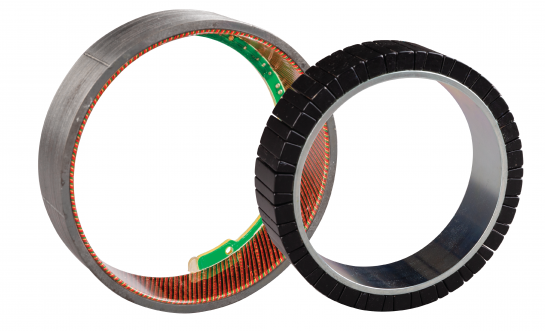One of the largest use-cases for ThinGap’s slotless motors are Gimbals, so much so that it considers itself to be the performance leader in Gimbal motors. From handheld applications for action cameras to large platforms designed for satellite-to-satellite communication, the applications of gimbals are endless. By using an array of different sensors and motors to counteract movement, electrically controlled gimbals serve to keep platforms stable and focused.
The three forces that gimbals are designed to counteract are tilt and pan (directional horizontal rotation), and roll (vertical rotation). These three axes of movement are counteracted by the sensors and electric motors that work to counteract the forces enacted on the platform. No matter the orientation, whatever is on the platform is held stable and even. By counteracting the forces of gravity with brushless electric motors, orientation can be held indefinitely (within reason). In the world of airborne and space Gimbals, three-axis refer to the angular movement as being Azimuth, Elevation, and Roll.

Image Credit: ResearchGate
In large systems, such as Turrets, the inner design works as a Gimbal allowing for control over roll movement and can be used in aircraft and satellites. On aircraft, optical platforms such as infrared, visible light, and lasers can be mounted on a Gimbal platform that is then fixed to a turret and placed within a fairing to protect it from aerodynamic forces.
Satellites use Gimbals for communication in a similar method for pointing and positioning, with the gimbals acting as the turret and gimbal unit alone, and a device called a fast-steering mirror delivering fine precision control that ensures a reliable optical data connection between satellites, either between low Earth orbit and geostationary satellites and between low Earth orbit satellites. This communication is conducted through pulses of laser light that transmit digital data in a similar manner to Morse Code used by telegraphs of the 19th century but in a far faster manner.

Image Credit: JAXA
What makes ThinGap motors ideal for Gimbal applications is the unique motor architecture that provides smooth movement. This smooth movement is zero-cogging which is afforded by ThinGap’s patented method for distributing stator coil wire windings within a thin cross section that eliminates traditional stator teeth, resulting in a motor without cogging torque.

Cogging is an unwanted magnetic torque disturbance caused by the winding patterns around the stator’s iron teeth that are the basis of “slotted” motors. Slotless motors eliminate cogging torque and offer smooth motion that is critical to optical systems for precision aiming, point and zooming at long standoff distances, and smooth motion for precise scanning.
ThinGap’s line of slotless motor kits feature high-performance, zero-cogging, high efficiency, and a lightweight design. The motor kits are ideal for smooth and precise motion. The entire LS Series offers a large through-hole and a low-profile form factor, ideal for integration into a wide range of different platforms. LS motors offer torque performance equivalent to traditional frameless motor kits available on the market, but unlike other slotless motor solutions, does not require a trade-off between torque output and smoothness.
